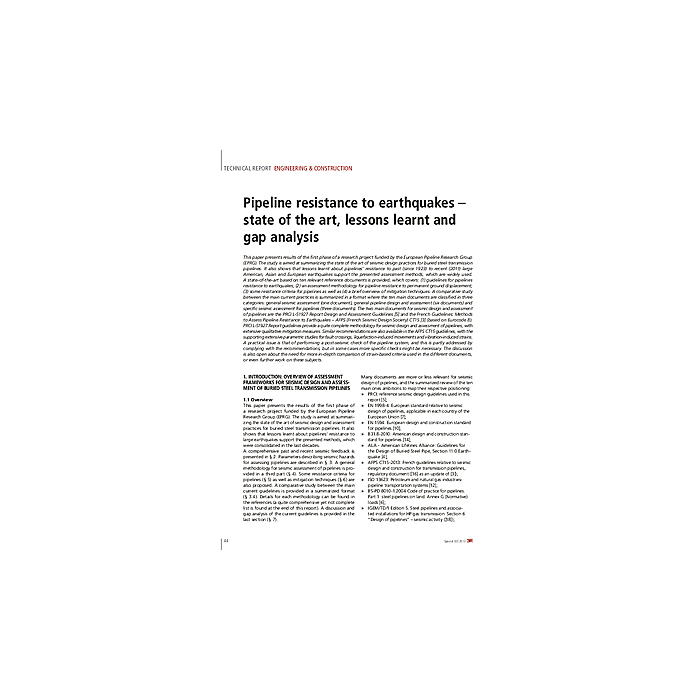Pipeline resistance to earthquakes – state of the art, lessons learnt and gap analysis
4,90 €
Auf Lager
Artikelnummer
01252_2013_SP2_04
This paper presents results of the first phase of a research project funded by the European Pipeline Research Group (EPRG). The study is aimed at summarizing the state of the art of seismic design practices for buried steel transmission pipelines. It also shows that lessons learnt about pipelines’ resistance to past (since 1923) to recent (2011) large American, Asian and European earthquakes support the presented assessment methods, which are widely used. A state-of-the-art based on ten relevant reference documents is provided, which covers: (1) guidelines for pipelines resistance to earthquakes; (2) an assessment methodology for pipeline resistance to permanent ground displacement; (3) some resistance criteria for pipelines as well as (4) a brief overview of mitigation techniques. A comparative study between the main current practices is summarized in a format where the ten main documents are classified in three categories: general seismic assessment (one document), general pipeline design and assessment (six documents) and specific seismic assessment for pipelines (three documents). The two main documents for seismic design and assessment of pipelines are the PRCI L-51927 Report Design and Assessment Guidelines [5] and the French Guidelines: Methods to Assess Pipeline Resistance to Earthquakes – AFPS (French Seismic Design Society) CT15 [3] (based on Eurocode 8). PRCI L-51927 Report guidelines provide a quite complete methodology for seismic design and assessment of pipelines, with extensive qualitative mitigation measures. Similar recommendations are also available in the AFPS CT15 guidelines, with the supporting extensive parametric studies for fault crossings, liquefaction-induced movements and vibration-induced strains. A practical issue is that of performing a post-seismic check of the pipeline system, and this is partly addressed by complying with the recommendations, but in some cases more specific checks might be necessary. The discussion is also open about the need for more in-depth comparison of strain-based criteria used in the different documents, or even further work on these subjects.
| Autoren | Charles Fernandez / Gonzague du Suau / Mures Zarea / Jorge Martin Rodriguez / Luca Bacchi |
|---|---|
| Erscheinungsdatum | 30.09.2013 |
| Format | |
| Zeitschrift | 3R - Special 2 2013 |
| Verlag | Vulkan-Verlag GmbH |
| Sprache | English |
| Seitenzahl | 13 |
| Titel | Pipeline resistance to earthquakes – state of the art, lessons learnt and gap analysis |
| Beschreibung | This paper presents results of the first phase of a research project funded by the European Pipeline Research Group (EPRG). The study is aimed at summarizing the state of the art of seismic design practices for buried steel transmission pipelines. It also shows that lessons learnt about pipelines’ resistance to past (since 1923) to recent (2011) large American, Asian and European earthquakes support the presented assessment methods, which are widely used. A state-of-the-art based on ten relevant reference documents is provided, which covers: (1) guidelines for pipelines resistance to earthquakes; (2) an assessment methodology for pipeline resistance to permanent ground displacement; (3) some resistance criteria for pipelines as well as (4) a brief overview of mitigation techniques. A comparative study between the main current practices is summarized in a format where the ten main documents are classified in three categories: general seismic assessment (one document), general pipeline design and assessment (six documents) and specific seismic assessment for pipelines (three documents). The two main documents for seismic design and assessment of pipelines are the PRCI L-51927 Report Design and Assessment Guidelines [5] and the French Guidelines: Methods to Assess Pipeline Resistance to Earthquakes – AFPS (French Seismic Design Society) CT15 [3] (based on Eurocode 8). PRCI L-51927 Report guidelines provide a quite complete methodology for seismic design and assessment of pipelines, with extensive qualitative mitigation measures. Similar recommendations are also available in the AFPS CT15 guidelines, with the supporting extensive parametric studies for fault crossings, liquefaction-induced movements and vibration-induced strains. A practical issue is that of performing a post-seismic check of the pipeline system, and this is partly addressed by complying with the recommendations, but in some cases more specific checks might be necessary. The discussion is also open about the need for more in-depth comparison of strain-based criteria used in the different documents, or even further work on these subjects. |
Eigene Bewertung schreiben


